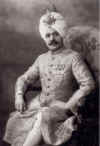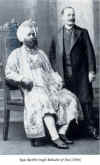| the-south-asian.com JANUARY 2002 | ||
| about us contact us data bank past issues the craft shop the print gallery | ||
|
JANUARY 2002 Contents Literature Pakistani
Literature Visual Arts South
Asian Art -
shared Rare
photographs of Indian Outlook Technology India
& China - major global Foreign
Investors in India's People Sports Books 'Knock
at Every Alien Door' Society
Books
|
Page 1 of 3
MAHARAJAS AT THE LAFAYETTE STUDIO
by Kavita Devgun Founded in 1880 in Dublin by James Stack Lauder, under the professional alias James Lafayette, Lafayette Studio boasts of an institutional memory that goes deep into history. The oldest photographic business in the world, it possesses pictures of a succession of Kings, Queens, Viceroys, Vicerines, spiritual leaders, business achievers and society ladies. Rulers and royalty from the princely states of India too, sailed across the seven seas to this studio, specifically for formal portraits. After the liquidation of the studio in 1952, the company’s archive of negatives was stored in an attic where it lay forgotten until 1988 when the foreman of the decrepit building uncovered it. The negatives became a part of the annals of the National Portrait Gallery of England. Prints developed from the collection were exhibited all over the world. And now, the curator Russell Harris has brought a collection of portraits of the royalty of India in their ceremonial robes, to Delhi. According to Ratna Sahai, publishing manager of Roli books, " This was a flagship exhibition. Now, spurred by the response, we intend to take it to Jaipur and Chandigarh next, and then onto other locations all over India." The collection is as captivating as it is intriguing.
Sirdar Charanjit Singh of Kapurthala…Striking a royal pose.
Mysore’s Yuvraja Sir Kanthirava Narasimharaja Wodeyar Bahadur.
Copyright © 2000 - 2001 [the-south-asian.com]. Intellectual Property. All rights reserved. |
|


